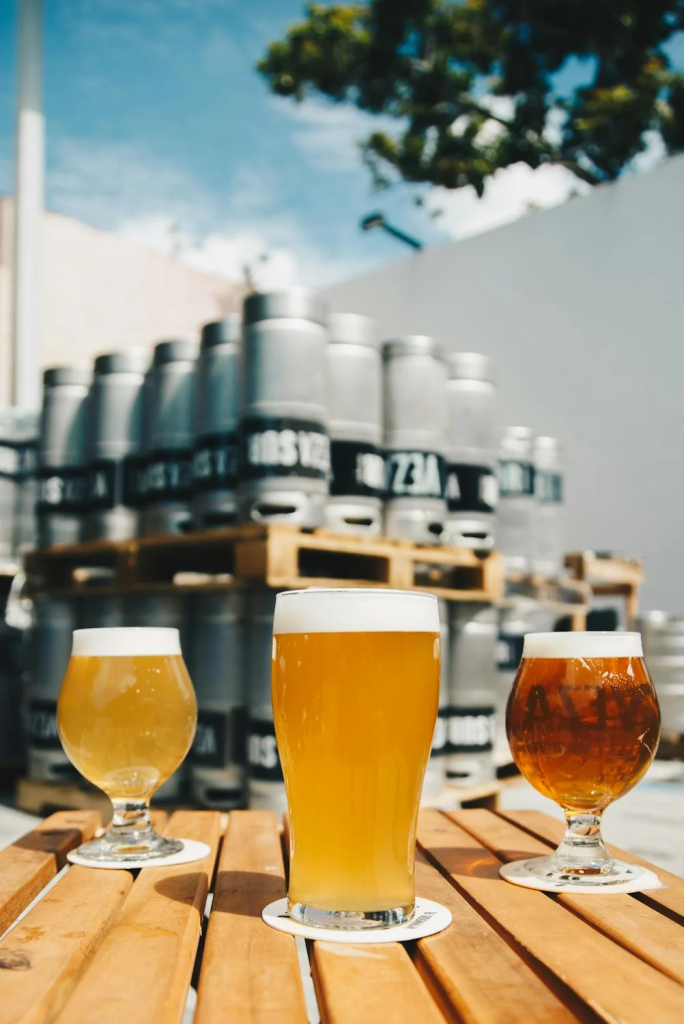Beer is one of the most popular beverages worldwide, loved for its diverse flavours, historical significance, and cultural impact. From ancient civilisations brewing rudimentary forms of beer to today’s craft breweries experimenting with innovative ingredients, beer has certainly come a long way.

However, while many enjoy beer, there is often confusion about the available types. One of the most commonly asked questions is: Are beer and lager the same thing? In this article, we’ll delve into this topic, breaking down the difference between beer and lager and exploring the unique characteristics that set them apart.
Are Beer And Lager The Same?
At first glance, the question seems simple, but it’s rooted in a common misconception. The answer is both yes and no. Beer is a general term for an alcoholic beverage made from fermented grains, water, hops, and yeast. Under this broad category, there are many styles and types, such as ales, stouts, porters, lagers, and more. So, while all lagers are technically beers, not all are lagers.
To better understand this, let’s look at the two primary categories of beer: ales and lagers. The main difference between them lies in the fermentation process, particularly the yeast used and the temperature at which the beer is brewed.
Yeast And Fermentation Process
The key factor distinguishing lager from other types of beer is the yeast used during fermentation. Ale yeasts (Saccharomyces cerevisiae) are top-fermenting, which means they float on top of the fermenting liquid and work at higher temperatures, typically between 60°F and 75°F (15°C and 24°C). This results in a faster fermentation, usually taking only a few days.
Lager yeasts (Saccharomyces pastorianus), on the other hand, are bottom-fermenting, meaning they sink to the bottom of the fermenting vessel and work at cooler temperatures, typically between 45°F and 55°F (7°C and 13°C). This slower, cooler fermentation process results in a smoother, crisper taste and usually takes several weeks to complete.
Flavor Profile Differences
Because of these fermentation differences, ales and lagers tend to have distinct flavour profiles. Ales are generally more complex, fruity, and robust, often featuring stronger aromas due to the quicker and warmer fermentation. Common ale varieties include IPAs (India Pale Ales), stouts, and porters, each with unique flavour notes that can range from bitter to sweet, depending on the hops and malt used.
Lagers, on the other hand, are known for their cleaner, crisper tastes with a more subtle flavour profile. Lagers tend to have fewer fruity esters than ales and are often described as refreshing and light. Popular examples of lagers include Pilsners, Helles lagers, and American adjunct lagers like Budweiser or Heineken.
While lagers may have a simpler flavour profile compared to ales, this simplicity allows the malt and hops to shine through in a balanced way.
What Are The Different Types Of Lager?
Now that we’ve established that lager is a type of beer, it’s important to note that there are various styles of lagers, each with its unique characteristics. Let’s explore some of the most well-known types:
Pilsner
- Pilsner is perhaps the most famous and widely consumed type of lager. Originating in the Czech Republic in the mid-19th century, it is a pale, golden beer known for its crisp, clean taste and moderate bitterness. Pilsners are typically brewed with noble hops, which contribute to their signature floral and spicy aroma. They are often lighter in body, making them an ideal choice for casual drinking, especially in warmer weather.
Helles Lager
- Hailing from Germany, the Helles Lager is a slightly maltier and less bitter version of the Pilsner. It has a golden colour, a smooth mouthfeel, and a subtle sweetness from the malt that balances the hop bitterness. Helles lagers are known for their easy drinkability, making them a staple in German beer culture.
Bock
- Bocks are strong, malty lagers that originated in Germany as well. They come in various substyles, such as Doppelbock (double bock), Maibock (a lighter, spring version), and Eisbock (an intensely concentrated version). Bocks are typically darker in colour, with flavours of caramel, toffee, and dark fruit. They tend to have a higher alcohol content than other lagers, making them more robust and full-bodied.
American Adjunct Lager
- This is the style most commonly associated with mass-produced beers in the United States, such as Budweiser, Coors, and Miller. American adjunct lagers use additional ingredients like rice or corn, which lighten the body and flavour of the beer. These lagers are known for their pale colour, mild flavour, and high carbonation, making them popular choices for casual consumption.
Each of these lager styles offers something unique, from the refreshing bitterness of a Pilsner to the rich maltiness of a Bock. Regardless of which style you choose, lagers generally share the characteristic of being smooth and easy to drink.
What Are The Most Popular Ales?
While lagers dominate the global beer market, ales hold their own with an array of popular and beloved styles. Let’s take a look at some of the most famous types of ales:
IPA (India Pale Ale)
- Perhaps the most iconic type of ale, IPAs are known for their strong hop bitterness and bold aromas, often featuring citrus, pine, or floral notes. They originated in England but gained massive popularity in the United States, where craft breweries have pushed the boundaries of hop-forward beer. The West Coast IPA is known for its intense bitterness, while the New England IPA offers a hazier, fruitier experience.
Stout
- Stouts are dark, rich ales that get their colour and flavour from roasted malt or barley. They are often associated with flavours of coffee, chocolate, and caramel. The most famous stout is Guinness, an Irish dry stout with a smooth, creamy texture. Other variations include imperial stouts (more robust) and oatmeal stouts (softer and creamier).
Porter
- Closely related to stouts, porters are dark ales with a slightly lighter body. They originated in London and typically have flavours of roasted malt, chocolate, and caramel. While stouts tend to be more robust, porters offer a more balanced profile with a smooth finish, making them an excellent choice for those who enjoy dark beers without the intensity of a stout.
Belgian Ale
- Belgium is famous for its rich beer culture, and Belgian ales are among the most distinctive in the world. These beers are often characterised by their fruity, spicy flavours, which are produced by the unique strains of yeast used during fermentation. Belgian ales include styles such as Tripel, Dubbel, and Saison, each offering a complex blend of flavours that can range from sweet and malty to tart and effervescent.
Conclusion
While beer and lager are related, they are not the same thing. Lager is a type of beer distinguished by its fermentation process, cooler temperatures, and bottom-fermenting yeast.
This results in a smoother, crisper taste that contrasts with the more complex and robust flavours found in ales. Both lagers and ales offer a wide range of styles, from light and refreshing to rich and hearty, ensuring that there’s a beer for every palate.
Whether you prefer the hop-forward bitterness of an IPA, the malty richness of a bock, or the smooth crispness of a Pilsner, the world of beer has something to offer everyone. So the next time you crack open a cold one, take a moment to appreciate the craftsmanship and history behind each sip!
For more information, click and read this guide “what is lagering”.
